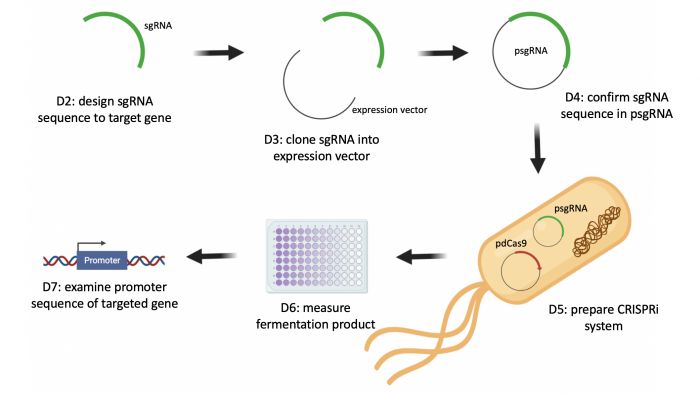Difference between revisions of "20.109(S22):Module 2"
Noreen Lyell (Talk | contribs) (→Module 2: metabolic engineering) |
Noreen Lyell (Talk | contribs) (→Module 2: metabolic engineering) |
||
| Line 8: | Line 8: | ||
In this module you will use a modified Clustered Regularly Interspaced Short Palindromic Repeats (CRISPR) system to modulate transcription in ''E. coli''. Specifically, you will use a CRISPR-based interference system to target a gene within the fermentation pathway of ''E. coli'' such that either ethanol or acetate production is increased. | In this module you will use a modified Clustered Regularly Interspaced Short Palindromic Repeats (CRISPR) system to modulate transcription in ''E. coli''. Specifically, you will use a CRISPR-based interference system to target a gene within the fermentation pathway of ''E. coli'' such that either ethanol or acetate production is increased. | ||
| − | <font color = #819081>'''Research goal: | + | <font color = #819081>'''Research goal: Increase the yield of commercially valuable byproducts in ''E.coli'' using CRIPSRi technology to target genes involved in mixed-acid fermentation pathway.'''</font color> |
[[Image:Sp22 M2 overview.png|center|700px|thumb|Image generated using BioRender.]] | [[Image:Sp22 M2 overview.png|center|700px|thumb|Image generated using BioRender.]] | ||
Revision as of 15:43, 24 January 2022
Contents
Module 2: metabolic engineering
In this module you will use a modified Clustered Regularly Interspaced Short Palindromic Repeats (CRISPR) system to modulate transcription in E. coli. Specifically, you will use a CRISPR-based interference system to target a gene within the fermentation pathway of E. coli such that either ethanol or acetate production is increased.
Research goal: Increase the yield of commercially valuable byproducts in E.coli using CRIPSRi technology to target genes involved in mixed-acid fermentation pathway.
Lab links: day to day
M2D1: Complete in-silico cloning of pdCas9 expression plasmid
M2D2: Design gRNA sequence for CRIPSRi system
M2D3: Clone psgRNA expression plasmid
M2D4: Confirm gRNA sequence in psgRNA expression plasmid
M2D5: Prepare for induction of CRISPRi system
M2D6: Complete CRISPRi experiment and measure fermentation products
M2D7: Examine features in gRNA-targeted genomic sequences
M2D8: Organize figures and outline text for Research article
Major assignments
Journal Club presentation
Research article
References
- CRISPR interference (CRISPRi) for sequence-specific control of gene expression. Nature Methods. (2013) 8: 2180-2196.
- Metabolic engineering of Escherichia coli for production of mixed-acid fermentation end products. Frontiers in Bioengineering and Biotechnology. (2014) 2:1-12.

